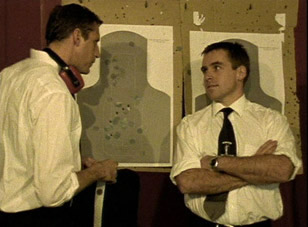| |
"Robert Kennedy said 'Every society gets the kind of criminal it deserves'. Well congratulations Australia, you've earned us." |
| |
Zach – leader of the Razor Eaters |
Unless you worked in the semi-pro end of video production or media education, you could be forgiven for not appreciating just how big an impact the arrival of the mini-DV format and low cost digital editing systems like Apple's Final Cut Pro had. The ability to edit video in non-linear fashion, to work with multiple sound and video tracks, and to easily add your own complex titles and animation was genuinely revolutionary. The leap from even Super-VHS was startling, and as the new format was digital, you were able to output the edited work at the same quality at which it was first captured. Perhaps inevitably, this has led to some unreasonable claims being made of quality and ability of mini-DV as a delivery format. I remember a professional editor (or that's what he claimed) who lasted only a single day in a media teaching post claiming enthusiastically that mini-DV was as good as film and would soon make it redundant. It isn't, not by a long way, and it absolutely didn't.
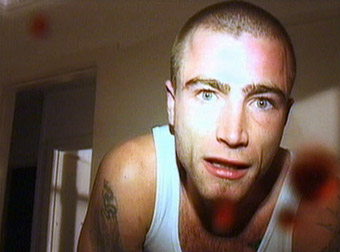
How times have changed. Or not. Mini-DV is now regarded as the runt in the litter by the film and video industry, with HD now the low-cost, high-quality medium of choice for even the semi-pro user. And now the same old claims are being made for that format's quality, that it's every bit as good as 35mm film, and so on. It's not. Technical issues aside, HD is a fine format, but it also has many guises, and the HD you'll shoot on a Canon HF10 palmcorder is nothing like the HD George Lucas used for the last Star Wars movie. Stick even semi-pro HD side-by-side with 35mm film and you'll soon see the difference – fellow reviewer Camus recently spent many weeks editing a film that was shot half on HD and half on 35mm and he swears that on the next project he'll work with 35mm only if he has the choice. There is, quite simply, nothing like the 35mm film image.
But low-end DV and even Sony's Hi-8 format have their own unique aesthetic, and as well as providing a low-cost medium for new directors looking to showcase their work and allowing documentary filmmakers to keep on shooting when the funding runs out, they have also been employed specifically for their non-professional appearance. The Blair Witch Project would never have convinced its initial American audience of its authenticity had it had the visual polish of 35mm, and recent forays into subjective camera filmmaking Cloverfield and Diary of the Dead may well be the start of a second wave of camcorder thrillers.
Made midway between Blair Witch and the more recent sprinkling of subjective viewpoint genre works, Razor Eaters was filmed partly on mini-DV and partly on film and relies on the audience being able to differentiate between the two. A quick plot synopsis should give you an idea of why. In Melbourne, Australia, hard-nosed detective Danny Burden looks back on his most recent case, that of a destructive and murderous youth gang known as The Razor Eaters. In his possession are a number of video tapes shot by these image-conscious and media-savvy noteriety seekers, who made a point of filming their every activity to preserve it and their fleeting fame for posterity. As Danny methodically sifts through the tapes, he tries to understand the gang's motivation and calculate the true extent of their crimes. The story of the gang's camcorder-recorded rampage thus unfolds in parallel to the shot-on-film police investigation into their crimes.
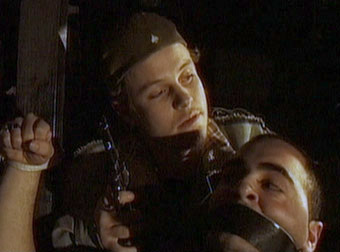
There's more than a whiff of Man Bites Dog and even Henry: Portrait of a Serial Killer to the sometimes uncomfortable intimacy this approach creates with the gang and their nefarious activities. But the early signs that they are a band of psychotic tearaways on a directionless spree of violence are called into question by snippets of their own back-stories (all have been negatively affected by drugs, either as ex-addicts or as close family of the same) and the targeting of drug dealers suggests a specific purpose to their destructive anger. This can't help but detract a little from their anarchic appeal and skate perilously close to casting them as ultraviolent moral crusaders, attack dogs for the unacceptable face of right-wing social respectability. But it's hard not to warm to the gang's disrespect for just about everything society at large holds dear and to the liberational aspect of their revolutionary rampage. That they are clearly having the time of their lives in the process is a hook that's difficult to shake – this is a movie, after all, and in movies it's the characters that buck the system that win the hearts and minds of an outsider audience.
But it's not that simple. We first meet them during their night-time occupation of a middle-class suburban house whose owners are fortuitously absent, and following their proclaimed intention to "fuck over the absurdly wealthy" and shoot any police that stand in their way, they stick a bomb in the microwave and leave the property to burn. Their first murder is not a drug dealer but a tailgater whom they stop and harass in a manner that recalls a memorable sequence in Lost Highway, but who is shot by one of the gang for no better reason than it amused him to do so. Later, as the distraught female employee of a Thai restaurant relates the details of a seemingly motiveless attack launched on her by hyperactive gang member Roger, our sympathies are so completely with her that we're with Danny all the way when, on watching a tape of the aggressor crowing about the assault, he angrily calls him a cunt. This split response to the gang's activities is perfectly captured in the character of Chris, a wheelchair-bound young drug dealer whose humiliation and intimidation at the gang's hands is rendered unwaveringly uncomfortable by his disability, instantly casting him in the role of victim in spite of his chosen profession.
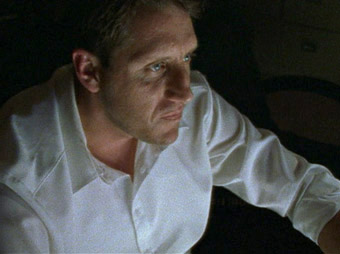
As the Razor Eaters' targets widen, the film can't help but recall Joel Schumacher's 1993 Falling Down, with figures of popular public dislike – a traffic warden, a lawyer, a self-centred professional footballer, a politician, a night-club bouncer etc. – rounded up and imprisoned in the gang's self-styled "dungeon of arseholes" and forced to sign confessions for their crimes against society. As with the targets of D-Fens' anger in Schumacher's film, the sheer spread of the victims ensures that even the pickiest audience is likely to find at least one inclusion to cheer for. Thus, in spite of myself, I almost found myself applauding the gang's hijacking of a car for the thumping volume and bass of its sound system, and their gun-to-the-head demand that its occupants repeat the mantra "All I am good for is my car stereo! The meaning of life is sub-woofer!" I also laughed out loud at the suggestion that the bouncer was nearly refused entry to the dungeon because "he didn't have the right shoes and his shirt was a bit crap."
The subjective camera approach may not be new, but it has a vigour and purpose here that precious few examples of the technique before or since have come close to boasting. The unpolished urgency of the camerawork directly reflects the gang's unbridled energy, which is most effectively counterpointed by the toned-down colour and cinematic calm of Danny's world. The waggly dizziness of Cloverfield is avoided through the filmmaking ambitions of gang-member Robert (played by director Young, who shot all of the video footage in character), who delights at finding editing equipment during a raid on an electronics store, and at one point pauses a mission in order to get a cool shot of the gang's car. For the most part, the video footage is striking in its authenticity, with Young's refusal to cinematically showcase the gunshots and explosions giving them an effectively (and at times disturbingly) documentary flavour.
The gang themselves are a prime example of characters that don't have to be likeable to be interesting, thanks to a string of supercharged but convincing performances from a quartet of up-and-coming young Australian actors. Particularly impressive is Richard Cawthorne as gang leader Zach, an adrenaline-fuelled but intelligent and enigmatic firebrand whose appearance as a shaven-headed, tattooed thug in no way prepares you for the lengthy and passionate monologues he uses to fire up his soldiers. Less showy but equally effective is Paul Moder's brooding, stoic turn as Danny Burden – your appreciation of Moder's contribution increases further when you learn that he was also the film's co-producer and the man behind its many and sometimes spectacular pyrotechnics.
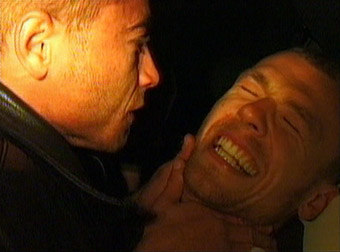
Morally ambiguous and even confused though Razor Eaters may be, it still makes for compelling and sometimes exhilarating viewing. The plotting is dense, the editing tight, the script is intelligent, literate, and laced with humour, and the use of digital video is both effective and appropriate. The sheer ingenuity and energy of the filmmakers (something that becomes all to clear in the support material) belies the film's low budget and should serve as an object lesson for any young director on how to build a well structured yet still impressively dangerous film from a basically simple idea. It's also intriguingly forward-looking – the inspiration came from a true-life (although less violent) youth gang known as The Hedge Burners, who were caught precisely because they used to videotape their acts of vandalism, an activity that has become increasingly commonplace in an era in which every media-aware and fame-seeking young aggressor carries an ever-ready video camera in their mobile phone.
That there will be a variance in picture quality is inevitable, given that Razor Eaters was shot partly on film and partly on domestic quality digital video, which notoriously ups the picture noise in low light conditions, of which there are many here. That's not a problem given the context and if anything adds to the authentic fell of the gang's footage. What is disappointing is that the film material doesn't look as good as it should, lacking the crisp richness that should clearly differentiate it from the video material. The difference is still evident, but not as stark as was probably intended.
A bigger issue is the 4:3 framing, which although might sound right for circa 2003 digital video but is inaccurate for the film's projected aspect ratio. The 1.85:1 letterboxed title sequence is a bit of a giveaway, but it's confirmed in the deleted and extended scenes, which enable a direct comparison between what is and what should have been. For the record, the Australian DVD apparently has the same cropped framing.
|
Compare the above grab from the film itself (above) with
the same moment from the extended scenes (below)
|
|
For the soundtrack, it's a choice between Dolby 2.0 stereo and 5.1 surround, and although they are on a par for much of the film, the 5.1 intermittently wins out, making occasionally good of the surrounds and most effectively capturing that car sub-woofer bass in a manner that, if you play it loud enough, could well earn you a visit from the Razor Eaters themselves. There is some very noticeable distortion in places, particularly during Zach's impassioned speech to arms dealer Lonnie Evans (Vince Gill, best known to genre fans as the Nightrider in Mad Max), but this is explained by Young on his commentary track as the result of an incompetent sound recordist, and is only audible at all thanks to some sharp work in post-production.
I might have a couple of gripes with the transfer, but in terms of extra features this 2-disc release is an absolute winner. The first two are on disc 1 and are attached to the main feature, the rest on disc 2.
Director's commentary
Director Shannon Young is joined by co-producer Nick Levy on a fine commentary track that hardly pauses for breath – there's so much ground covered here that it leaves you wondering what the other extras can add. All aspects of the production are touched on and there's a wealth of information on the shoot itself. There are some choice technical reveals here and a few engaging anecdotes, including their minor run-ins with the law, the use of 'slabs' of beer as currency, and a nightmare day in which Shannon had to film while suffering from chronic food poisoning. The director's buzz at being presented with an award by Mark 'Chopper' Read at its Melbourne Underground Film Festival premiere reflects amusingly on his complaint that we tend to treat criminals as celebrities, and it's here that I learned that Young began his career co-directing with good friend James Wan of Saw fame – Wan even appears here as the corpse of a drug dealer and designed the rather smart Razor Eaters t-shirts. I even picked up an amusing new phrase when Young expressed his anguish at one of the problems in production by assuring us that he had "a major league shit-cracking."
Cast Commentary
The participants here are Paul Moder (Danny Berdan and the film's co-producer), Teague Rook (Orville, the gang's studious explosives expert), Richard Cawthorne (Zach), Fletcher Humphrys (Roger) and Campbell Usher (Anthony). A more jocular commentary than the one above, it's still busy with information on the shoot and the characters, while the inevitable crossover with the previous commentary sometimes provides a different perspective on the same events. We discover that Moder is a gun enthusiast and that the young cast had the time of their lives with the weaponry, an interesting reflection on Young's intention that the film should comment negatively on just such an attitude. Everyone contributes, but Moder dominates.
Making Of (74:55)
A substantial and engrossingly structured documentary that tells the story of the film from conception to release and its successful festival appearances, achieved through a blend of retrospective interviews, behind-the-scenes material, outtakes, audition and rehearsal footage, and even extracts from earlier films of the key players. Once again there's some crossover with the commentary tracks, but there's too much good stuff here to complain. Moder's commitment to the project becomes particularly clear – he repeatedly takes the role of the victim in the casting and rehearsals, and appears to have installed every squib, rigged up every explosion, and sorted every firearm himself. We also get a detailed look at the moment when director Young was injured when a blank shell was fired in his face – ever the filmmaker, he suffered the pain for a full two minutes until the shot was completed. Watch out for the jocular warning about strong language at the start and some amusing snippets cut into the end credits.
Deleted Scenes (38:19)
Actually deleted and extended scenes, few of which add much to your appreciation or understanding of the characters but are of interest nonetheless. The scene in which the gang individually introduce themselves to camera did make me feel a little slow for not realising before that if you correctly arrange the first letters of each of their names you get the word RAZOR. As mentioned above, these scenes are all in their correct aspect ratio, unlike the film itself.
A Look at FX (2:36)
A very brief look at a couple of the post-production effects – the muzzle flash replacement is a useful intro for digital filmmaking newcomers.
Fletcher Humphrys Video Diary (32:31)
A rather rambling and ramshackle extra that nonetheless has its moments, several of which were poached for the documentary detailed above. There's yet more footage here suggesting that Moder was the busiest person on the shoot.
Music video (3:40)
An uninspiring music video for a thrash metal version of the main theme that follows the tired tie-in formula of stylised footage of the band cut with extracts from the film.
Razor Eaters has the kind of intelligence, energy and filmmaking ingenuity that American independent cinema once had in abundance but seems to be too rarely displaying these days. It's a little ragged round the edges, but in these days of over-polished, CG-driven mainstream pap, this only serves to increase the film's outsider appeal. Ilc Entertainment's 2-disc DVD really scores on both the quantity and quality of its extra features (well, most of 'em) and would come wholeheartedly recommended were it not for that cropped transfer, something that is both inexplicable and unacceptable at a time when widescreen TVs are the norm rather than the exception. The quality of the film and the extras makes it still worth owning, but the complaint stands.
|
